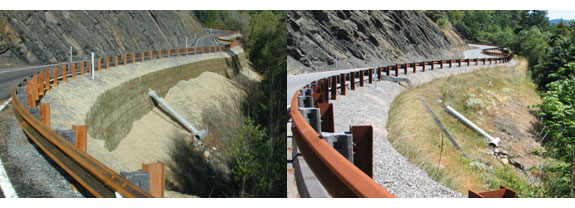ROADSIDE REVEGETATION
An Integrated Approach to Establishing Native Plants and Pollinator Habitat
Learn
Grass-Faced MSE Walls
| Location: | Agness-Illahe Road - County Rd 375 |
| Lat/Long: | N42o37'51", W124o03'27" |
| Dates Implemented: | Summer 2003 |
| Client: | Western Federal Lands Highway Division |
| Planners: | R6 Restoration Services Team |
| Contractors: | Ladd and Associates Inc, Stone Nursery |
| Case Number: | 0001 |
| Date Submitted: | November 2008 |
| Focus Area: | Biotechnical Engineering |
Background and Objectives
The Agness-Illahe Road accesses a high recreation use area along the Rogue River in southern Oregon. The scenic values of the area required that MSE walls be screened from road and river views with native vegetation.
Implementation
The MSE wall was installed in summer 2003 on 1.5 miles of road. The exterior of the wall was constructed with a 1 foot wide basket that held loosely placed, manufactured soil. The soil was created using loam (from an excavated terrace deposit) and compost at a 3 to 1 rate. Lime, slow release fertilizer, and mycorrhizae were also added. Prior to installation, turf reinforcement mats were rolled out and seeds were spread evenly across the fabric. A non-toxic co-polymer glue was applied and allowed to dry, binding the seed to the mats. The main species used in the mix was California fescue (Festuca californica), with minor quantities of nude buckwheat (Eriogonum nudum) and woolly sunflower (Eriophyllum lanatum). Seeded mats were placed in the front of the soil baskets and soil was filled behind.
Findings
In the fall 2003, seeds germinated and by spring all walls were fully vegetated, primarily with California fescue. Monitoring of one of the main walls two years after implementation showed that 90% of the wall surface was screened by vegetation.
Photographs
The picture on the left was taken in 2003 several months after the MSE wall was installed. The picture on the right is three years later when the wall was fully vegetated.

Applicability
The findings from this project are applicable to north and east aspects of the Coast Range, Siskiyou Mountains, and Cascade Mountains. The techniques and species selection should be site specifically tested before applying them to sites that are geographically different (semi-arid to arid environments) or sites with southern exposures. Several years prior to installation of our project, we tested blue wild rye (Elymus glaucus) and California fescue in small test walls and found that California fescue outperformed blue wild rye in appearance and longevity. We also found that erosion fabric with the greatest loft and thickness had the best germination.
Related Links
Establishing Native Grasses on Soil Faced Retaining Walls (3.63 MB PDF)
Contact Information
David Steinfeld, USDA Forest Service; 541-552-2912, dsteinfeld@fs.fed.us